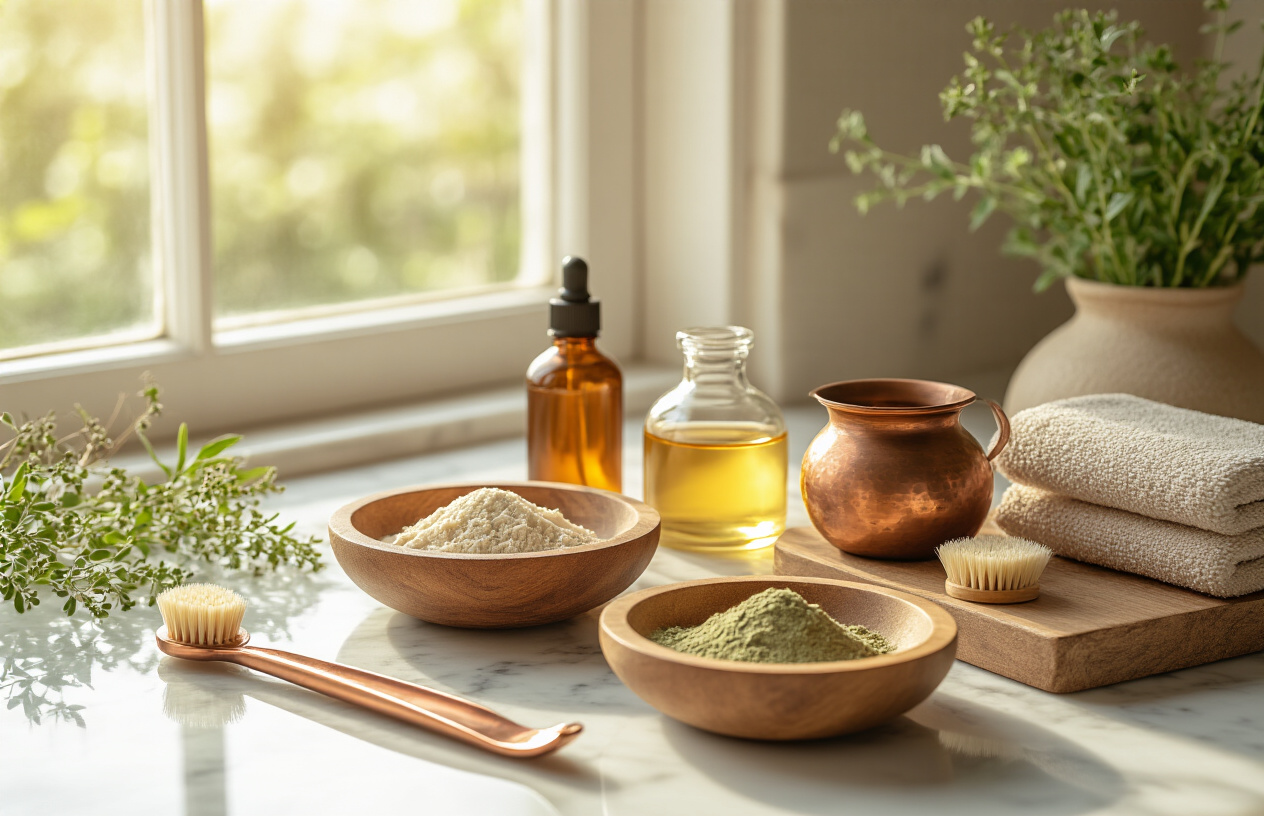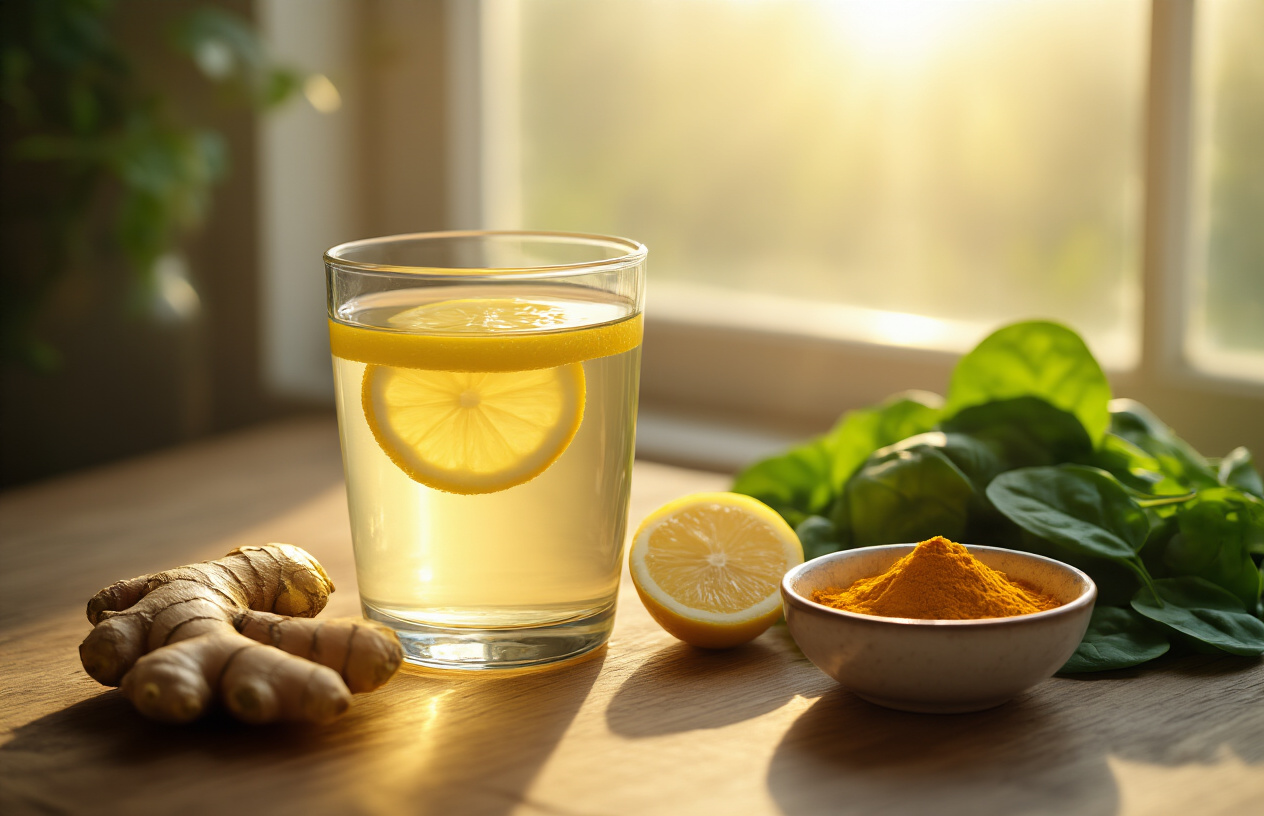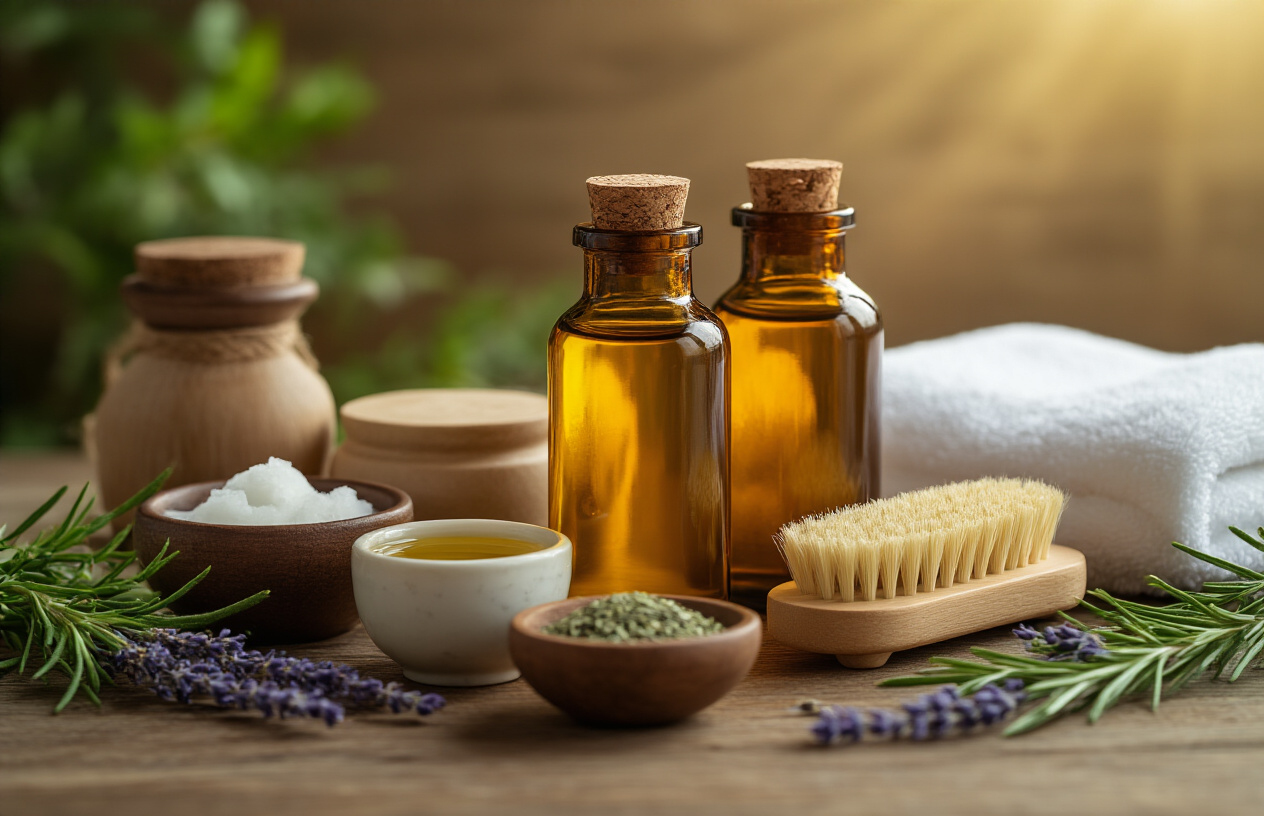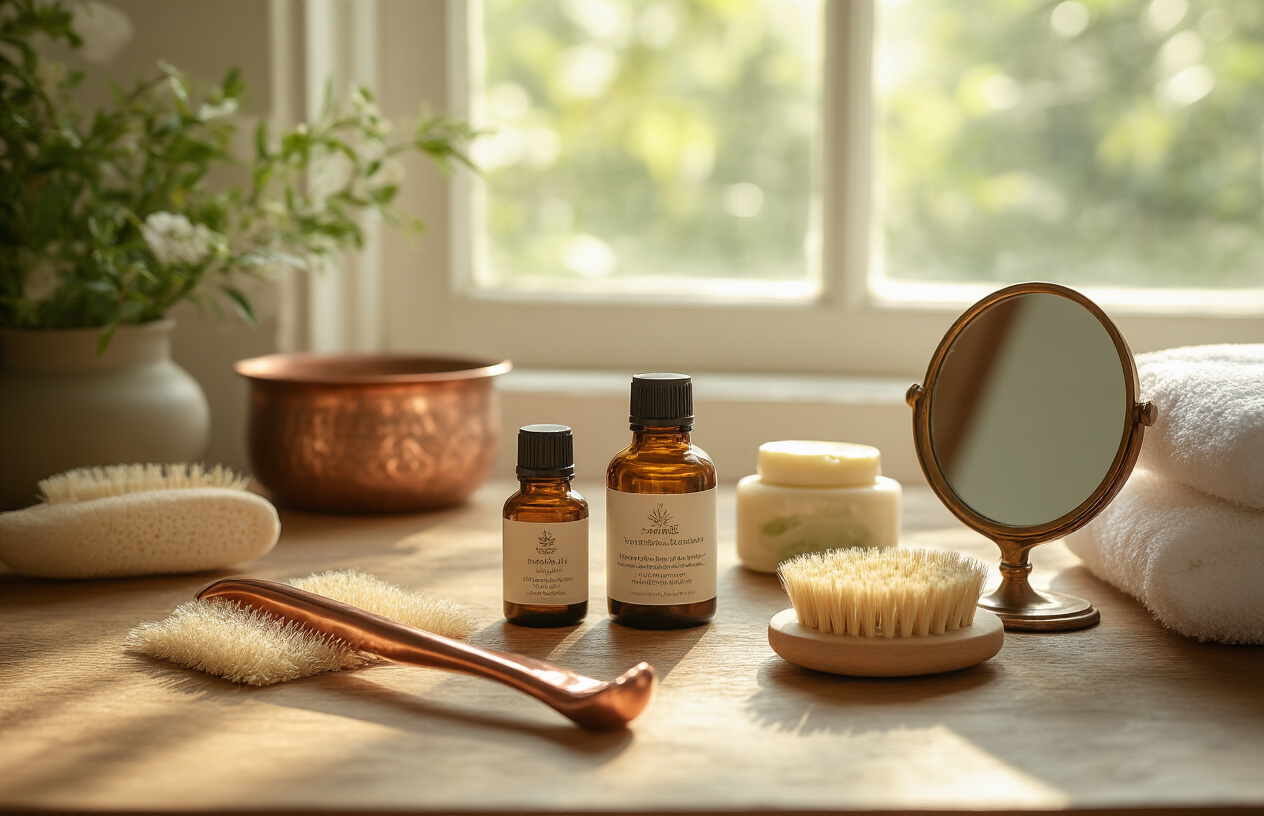
Starting your day with an ayurvedic morning routine can completely transform how you feel and function throughout the day. This ancient wellness practice, known as dinacharya in Ayurveda, helps balance your body’s natural rhythms and boost your energy levels.
This step-by-step guide is perfect for anyone looking to incorporate traditional ayurvedic morning rituals into their modern lifestyle – from complete beginners to those already familiar with Ayurvedic principles. You don’t need hours of free time or expensive products to get started.
We’ll walk you through essential morning cleansing rituals that help remove toxins and prepare your digestive system for the day ahead. You’ll also learn about oil treatments and breathwork practices that nourish your body and mind. Plus, we’ll show you how to customize these ayurvedic self care routine practices based on your unique constitution and schedule.
Ready to wake up feeling more refreshed and centered? Let’s dive into building your personalized ayurvedic morning routine.
Wake Up Early and Start Your Day Mindfully

Rise before sunrise to harness nature’s peaceful qualities
According to Ayurveda, waking early captures the loving (sattvic) qualities present in nature before dawn, bringing peace of mind and freshness to the senses. The ideal wake-up time varies by dosha: Vata types should rise around 6 a.m., Pitta types by 5:30 a.m., and Kapha types by 4:30 a.m. Starting your day before sunrise allows you to harness the light, expansive quality of Vata hour, which rules movement and helps energize your system for the day ahead.
Practice gratitude with a morning prayer or intention
Before leaving bed, take a moment to connect spiritually with a morning prayer or intention setting. A traditional Ayurvedic prayer expresses gratitude: “Dear God, you are inside of me, within my very breath, within each bird, each mighty mountain. Your sweet touch reaches everything and I am well protected. Thank you God for this beautiful day before me. May joy, love, peace and compassion be part of my life and all those around me on this day. I am healing and I am healed.” After this prayer, touch the ground with your right hand, then bring the same hand to your forehead with love and respect to Mother Earth.
Cleanse your aura by moving hands over face and chest
Right after waking, look at your hands for a few moments as a mindful transition into consciousness. Then gently move your hands over your face and chest down to the waist – this simple gesture cleanses your aura according to Ayurvedic tradition. This practice helps clear energetic residue from sleep and prepares your energy field for the new day. Take a few deep breaths during this process and welcome your body, mind, and spirit into another day with intention and awareness.
Essential Morning Cleansing Rituals

Splash Face with Cold Water and Rinse Mouth
After awakening mindfully, begin your ayurvedic morning cleansing rituals by splashing your face with cool, refreshing water. This simple yet powerful practice helps awaken your senses and removes any accumulated impurities from sleep. Simultaneously, rinse your mouth thoroughly with clean water to clear oral toxins and prepare your system for the day ahead.
Wash and Massage Eyes with Appropriate Solutions for Your Dosha
Next, gently wash your eyes with cool water and massage your eyelids by rubbing them softly. After cleansing, blink your eyes seven times and rotate them in all directions to stimulate circulation. Different dosha types benefit from specific eye wash solutions: Vata and Kapha types can use a tridoshic triphala eyewash made by boiling ¼ teaspoon triphala in one cup water for 10 minutes, then cooling and straining. Pitta types should use cool water or organic rose water (avoiding commercial varieties with harsh chemicals). Kapha types can try diluted cranberry juice mixed with 3-5 drops in a teaspoon of distilled water for additional cleansing benefits.
Drink Warm Water or Lemon Water to Flush Your System
Complete your morning cleansing by drinking a glass of room temperature water, ideally from a pure copper cup that has been filled the night before. This essential practice washes your gastrointestinal tract, flushes the kidneys, and stimulates healthy peristalsis for proper elimination. Avoid starting your day with tea or coffee, as these beverages can drain kidney energy, stress your adrenals, cause constipation, and create unhealthy dependencies that work against your natural detoxification processes.
Eliminate Toxins and Prepare Your Digestive System

Have a regular bowel movement to clear yesterday’s waste
Now that you’ve awakened and prepared your body, the next essential step in your ayurvedic morning routine is elimination. Sit or better yet squat on the toilet to have a bowel movement, clearing yesterday’s waste from your system. This natural detoxification process removes improperly digested food from the previous night’s meal. If elimination doesn’t occur naturally, drinking room temperature water followed by sitting on the toilet at a set time each day helps regulate bowel movements. Alternate nostril breathing may also assist this process. After evacuation, wash the anal area with warm water, then cleanse your hands thoroughly with soap to maintain proper hygiene.
Scrape your tongue to remove bacteria and stimulate organs
Following elimination, tongue scraping becomes a powerful detoxification practice in your ayurvedic morning routine. Gently scrape your tongue from back to front for 7-14 strokes until you’ve covered the entire surface. This removes the filmy white coating of ama (toxins) that accumulates overnight, preventing harmful bacteria from being reabsorbed into your system. The practice stimulates internal organs, aids digestion, and eliminates dead bacteria while improving bad breath. Ideally, vata types can use a gold scraper, pitta types benefit from silver, and kapha types should use copper, though stainless steel works effectively for all constitutional types.
Clean teeth with natural, astringent ingredients
With toxins cleared from your tongue, complete your oral hygiene with natural tooth cleaning. Always use a soft toothbrush paired with astringent, pungent, and bitter toothpaste or powder to support your ayurvedic detox morning routine. Traditional Indian neem sticks serve as natural toothbrushes, dislodging fine food particles while strengthening gums. Licorice root sticks offer another traditional option. For personalized care, roasted almond shell powder works well for vata and kapha types, while ground neem powder specifically benefits pitta constitution. These natural ingredients provide gentle yet effective cleaning while supporting your body’s natural detoxification processes during your morning ayurvedic rituals.
Strengthen Your Mouth and Respiratory System

Gargle with Warm Sesame Oil to Improve Voice and Jaw Strength
Gandusha, or gargling with warm sesame oil, is an essential Ayurvedic practice that lubricates the temporomandibular joint responsible for chewing and talking while keeping it pain-free. This ancient technique involves swishing oil in your mouth to strengthen oral structures and enhance voice clarity by supporting the control mechanisms of speech through your lips, jaws, teeth, cheeks, and tongue.
Chew Sesame Seeds or Dates to Strengthen Teeth and Gums
Ayurvedic oral care emphasizes using bitter, astringent, and pungent substances to massage and strengthen the gums while promoting oral health. Chewing on natural materials like sesame seeds helps stimulate the mucous membrane and oral cavity, facilitating salivary secretion and supporting the health of teeth and gums through gentle mechanical action that promotes circulation.
Apply Nasal Drops to Lubricate Sinuses and Enhance Mental Clarity
Nasal application of oils helps lubricate the sinuses and respiratory passages, supporting clear breathing and mental function. This practice complements the morning cleansing rituals by ensuring the nasal passages remain moist and free from congestion, which directly impacts your ability to breathe clearly and maintain optimal respiratory health throughout the day.
Nourish Your Body with Oil Treatments

Put oil drops in ears to prevent hearing issues and TMJ
Now that we have covered digestive preparation, applying 5 drops of warm sesame oil in each ear helps address various vata-related disorders. This simple practice can alleviate conditions such as ringing in the ears, excess ear wax, poor hearing, lockjaw, and TMJ problems, which are all caused by vata imbalance in the ears.
Massage head and body with warm oils suited to your dosha
With this foundation established, the next step involves abhyanga or full-body oil massage, a traditional Ayurvedic practice that promotes overall health and well-being. This nourishing ritual should be performed daily using warm, dosha-specific oils: vata types benefit from warming sesame oil, pitta individuals should use cooling sunflower or coconut oil, while kapha constitutions require warming sunflower or mustard oil. Apply the oil generously from head to toe, using long strokes for limbs and circular motions for joints, chest, and abdomen, concentrating especially on the head, ears, and feet for maximum benefit.
Take a refreshing bath to cleanse and energize
Previously, we’ve allowed the oil to absorb for 10-20 minutes, and now it’s time for a cleansing bath. Bathing removes sweat, dirt, and fatigue while bringing energy to the body, clarity to the mind, and a sense of holiness to your life. Use warm water with a gentle cleanser or traditional bath powder to wash away the oil, then pat dry to remove excess water, leaving your skin nourished and refreshed.
Prepare Your Appearance and Senses

Dress in Clean Clothes for Beauty and Virtue
Previously, I’ve discussed the importance of morning cleansing rituals, and now that we’ve covered physical purification, wearing clean clothes brings beauty and virtue to complete your ayurvedic appearance preparation. This simple yet profound practice supports your overall well-being by maintaining energetic cleanliness throughout the day.
Apply Natural Scents and Essential Oils for Freshness and Confidence
With this foundation established, using natural scents, essential oils, or perfumes brings freshness, charm, and joy while giving vitality to the body and improving self-esteem. For vata constitution, the best scent is hina or amber. Pitta types should use khus, sandalwood, or jasmine, while kapha individuals benefit from amber or musk to balance their energetic needs.
Use Rose Water or Cool Water to Refresh Your Eyes
Now that we’ve addressed scenting the body, refreshing your eyes completes this preparatory phase. Pitta types should use cool water or rose water made from organic rose petals, as most commercial rose water contains chemicals that sting the eyes. This gentle practice cleanses and soothes the eyes while preparing your senses for the active day ahead.
Energize Through Movement and Breathwork

Exercise According to Your Dosha’s Needs and Capacity
With the cleansing rituals complete, it’s time to energize your body through mindful movement. Ayurveda recommends exercising daily to half of your capacity – until sweat forms on the forehead, armpits, and spine. Each dosha type requires different exercise approaches: Vata individuals should focus on slow, gentle movements like 12 Sun Salutations performed slowly, along with leg lifting, camel, cobra, cat, and cow poses. Pitta types benefit from calming exercise such as 16 Moon Salutations done at moderate speed, plus fish, boat, and bow poses. Kapha constitutions thrive with vigorous exercise including 12 rapid Sun Salutations, bridge, peacock, palm tree, and lion poses to stimulate circulation and energy flow.
Practice Pranayama Breathing Techniques for Balance
After your physical exercise, transition into pranayama breathing practices to balance your nervous system and prepare for meditation. Each dosha has specific breathing techniques that support their unique constitution: Vata individuals should practice 12 alternate nostril breaths to calm their naturally active energy. Pitta types benefit from 16 cooling shitali breaths, which involves curling the tongue lengthwise and breathing through it to reduce internal heat. Kapha constitutions should perform 100 bhastrika breaths – short, fast breaths that help stimulate their naturally slower metabolism and energy levels.
Meditate for at Least 15 Minutes to Cultivate Inner Peace
Following your breathwork, dedicate at least 15 minutes to meditation practice both morning and evening. This crucial step brings balance and peace into your life, completing the physical and energetic preparation of your ayurvedic morning routine. You can meditate in whatever way you’re accustomed to, or try the traditional “Empty Bowl Meditation” technique. Regular meditation practice helps establish the mental clarity and inner stability needed to maintain the benefits of your entire morning routine throughout the day.

Building an Ayurvedic morning routine transforms how you experience each day by establishing balance in your body, mind, and consciousness. From waking early and cleansing rituals to oil treatments and energizing movement, each step works together to regulate your biological clock, improve digestion, and generate self-esteem, discipline, and peace. These ancient practices help you align with nature’s rhythms while addressing your unique constitutional needs.
Remember that lasting change happens gradually. Start by incorporating one or two practices that resonate with you most, then slowly add others over the coming weeks. As you establish this sacred morning foundation, you’ll likely discover increased energy, mental clarity, and overall well-being that carries you through your entire day. Your commitment to these time-tested rituals is an investment in your long-term health, happiness, and longevity.